Tidal Energy: A Priceless Resource
Tidal energy is a form of hydroelectric power relying on tides that affect large bodies of water such as bays, estuaries, lakes and inlets in order to generate clean energy from flowing water and ocean currents. Compared to hydro power, wind power and solar, tidal is currently much less popular in the UK due to recent government policy on the development of sustainable energy.
The unwillingness of the UK government to put real resources behind the development of tidal energy has been a stain on its reputation. Too much reliance on the Free Market and not enough government-led projects holds back the development of this priceless resource. .For example:
- “Government rejects plan for £1.3bn tidal lagoon in Swansea. Ministers say project is too expensive but decision sparks widespread criticism.” Guardian
How does tidal power work?
Tidal power stations harness the kinetic energy from tidal currents to produce electricity. Since the movement of water is the key to energy production with this form of renewable energy, underwater turbines are the common component in all tidal power stations, no matter their scale. Moving water makes the turbines turn which produces electricity both during the incoming and outgoing tides. There are four main types of tidal power plant currently in operation or planning stages:
Tidal Barrage
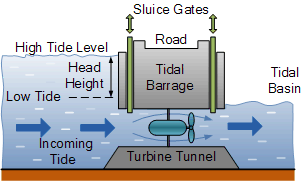
Tidal barrages have much in common with hydroelectric dams and canal locks. They run the width of an estuary where river and seawater meet, leading to a significant change in water level that can be exploited for energy generation.
The power of ebb and flow
The process starts with opening sliding gates, called sluices. They let the incoming tide in until the high tide point has been reached. Behind the sluice gates, you have turbines that turn as water passes through. Once the tide has flowed in one direction, the sluice gates are firmly shut to retain the water flow and its valuable potential energy.
Once the water level on the other side of the barrage has decreased sufficiently, the gates are opened again so the water can pass through, moving the turbines with significant energy to boot. The power station turns the movement from the turbines into renewable electricity. With four tidal currents at regular times in any given day, electricity generation is predictable which helps with the operation of the barrage and its sliding gates.
Additionally, a tidal barrage can seamlessly incorporate a lock system to enable continued usage of established shipping lanes.
Pump it up!
Current power grids don’t really have the ability to store electricity which generally means whatever isn’t used is wasted. At the same time, renewable power generators are forced to operate at less than full capacity for fear of overloading the national grid.
The ability for tidal power turbines to go in reverse is shared with hydropower dam turbines. The point of being able to go in reverse is that allows for water to be pumped from one area to another, often higher, reserve area, often called Pumped Storage.
This process to move water against earth’s gravitational pull obviously requires energy consumption but it also plays a vital regulatory role in our antiquated electrical distribution infrastructure.
Pumped storage can use up excess electrical power output from renewable energy sources by turning it into mechanical energy to move water into storage for later use. These ad-hoc water reserves act as hydraulic batteries that can be harnessed quickly by releasing water back through submerged tidal turbines. With the extra water volume being pushed through, this will maximise the generating capacity right when it’s most needed while having soaked up the excess electricity in the grid.
Tidal streams
Tidal stream generators are essentially wind turbines designed for underwater use. While tidal barrages can take a long time to build, tidal stream generators, more commonly known as (TEC) tidal energy converters, are much faster to deploy because of their free-standing and independent nature. Unlike the full scale commitment required by tidal barrage projects, operators can easily test the waters with standalone test tidal stream turbines.
Unlike wind turbines, tidal turbines have a higher power output potential than equivalent wind energy counterparts. This is because water is 800 times denser than air which means that even at low tidal flow speeds a tidal turbine will still keep on churning, unlike its wind turbine relatives which are more likely to just sit pretty with low wind speeds.
With all this potential, tidal turbines remain very much bleeding edge technology, there are several competing designs vying for mainstream acceptance.
Axial tidal turbines
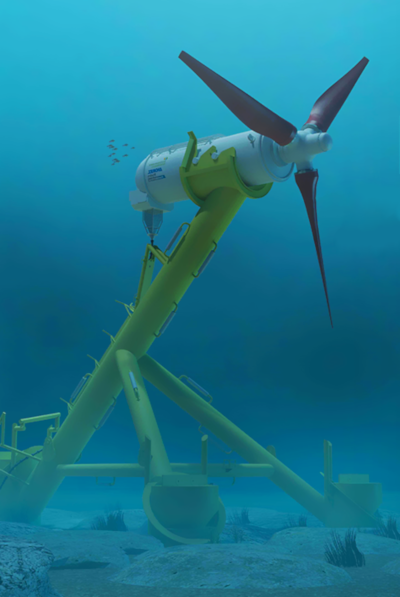
These are closely related to traditional wind turbines but instead, they operate out of sight underwater. Axial tidal turbines can be fixed in place through foundations dug straight into the seabed. A more progressive ocean energy alternative is to have a semi-floating turbine tethered by several mountain points. The advantage of the tethered turbine is that it can instinctively orient itself to better face the tidal stream.
Crossflow turbines
If you took an axial turbine and turned it on its side so that its axle is perpendicular instead of parallel to the coastal bed, you get a crossflow turbine. Such a significant change requires a radical redesign of the turbine blades, such as a futuristic-looking helical hydrofoil that can better exploit more sluggish water currents.
Flow augmentation
By surrounding a standard tidal turbine with a shroud and affixing it to the seafloor, you can multiply water flow through the turbine design of your choosing. This variation on standard axial and crossflow designs acts as a supercharger, increasing energy potential.
Tidal kite turbines
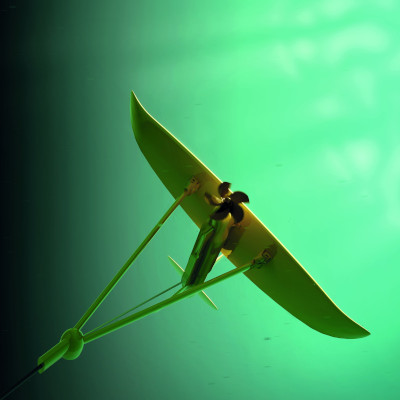
This design is flexible enough to move along the tidal stream. The concept dates back to the aftermath of World War II when Europe was reeling from the destruction of much of its energy generating sources.
Tidal kites span an average of 35 feet and they are able to maintain a neutral flotation profile through the ebb and flow cycle. They also have a gearless turbine that efficiently converts the flow of water into electricity.
Tidal power stations in the UK, Europe and the world
There are many tidal power plants, big and small, dotted around estuaries and coastlines around the world. Let’s have a look at some of the most notable ones.
United Kingdom
Being entirely surrounded by water, the UK has unparalleled tidal energy potential, much of it currently untapped.
Strangford Lough tidal stream generator
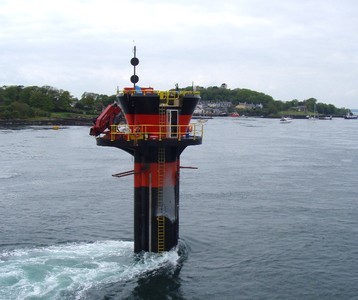
The Seagen system was based on a standalone two axial turbine design developing 1.2MW of electrical power in Northern Ireland. The turbine rotors could be raised for maintenance purposes. The site generated electricity from 2008 until its closure and dismantling in 2017.
Bluemull Sound tidal stream array
This is a 20 million Euro project based in the Shetlands focused on proving the tidal concept from design board to decommissioning. The goal is to bring down the cost of tidal energy development and operation by over 40% to increase confidence and investor interest in this renewable option.
Meygen Tidal Project
The project officially launched in 2016 and there are now four turbines capable of outputting 6MW of electrical power. More turbines are planned for the Pentland Firth site to create one of the largest tidal power projects with a 25-year operational cycle.
Europe
France is the current regional leader when it comes to tidal energy, especially with the recent changes in UK renewables policy.
Rance tidal power station (France)
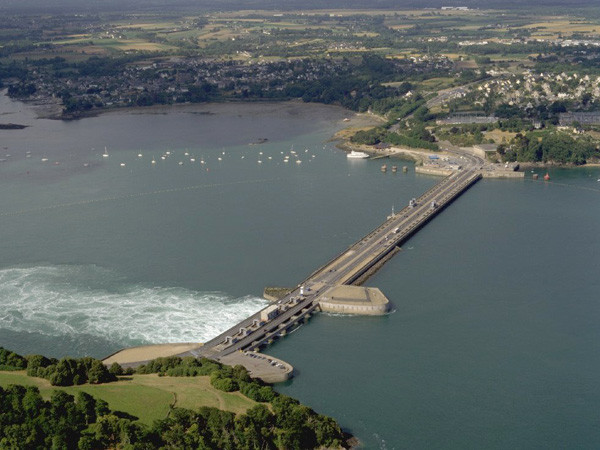
The grand-daddy of all tidal barrage power plants runs across the Rance river estuary in North West coast of France. It was built in a six year sprint during the swinging 60s and it has been generating up to 240MW consistently.
Rest of the world
While what France has achieved is impressive they are not the only country to have brought about large scale tidal projects.
Sihwa Lake Tidal Power Station (South Korea)
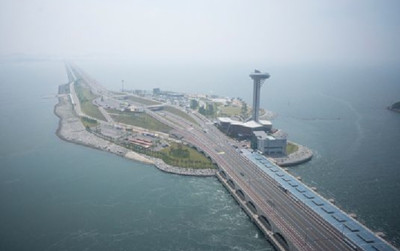
This significant renewable project was built on a seawall that initially was set up for flood protection and agricultural water storage. The newly-built power plant started operating in 2012 and has started to improve the quality of the previously stagnating reservoir by circulating fresh seawater, in addition to reaching a total power capacity of 254 MW.
Stop Press: Wind Power is not as reliable as Tide and Wave energy……
In June this year, Bloomberg reported that the UK went nine days without generating almost any wind power. From 26 May to 3 June, power generated from UK wind farms fell from more than 6,000MW to less than 500MW. In contrast, scientists already know the volume of water and the level of power the tidal equipment will likely generate before construction.
Tidal power is also relatively prosperous at low speeds, in contrast to wind power. Water has one thousand times higher density than air and tidal turbines can generate electricity at speeds as low as 1m/s, or 2.2mph. In contrast, most wind turbines begin generating electricity at 3m/s-4m/s, or 7mph-9mph.
Moreover, technological advances in the industry will only drive cheaper and more sustainable tidal power solutions.
“Historically, wave energy converters have been costly and large compared to their energy output. But we shouldn’t let that define the future of the tidal industry. Around 10%-20% of global electricity demand could be met by wave power,”
says Diego Pavia, chief executive officer at InnoEnergy.
“It’s a very predictable energy source and typically offsets the intermittency of solar and wind – balancing the grid with a low levelised cost of energy. One of our assets, CorPower, is challenging how the industry thinks about wave energy by using principles of the human heart. Through its wave energy converter, the company is able to deliver five times higher wave energy absorption than other technologies. And that’s why the power of wave energy should not be overlooked.”
Advantages of tidal energy: longevity of equipment
Tidal power plants can last much longer than wind or solar farms, at around four times the longevity. Tidal barrages are long concrete structures usually built across river estuaries. The barrages have tunnels along them containing turbines, which are turned when water on one side flows through the barrage to the other side. These dam-like structures are said to have a lifespan of around 100 years. The La Rance in France, for example, has been operational since 1966 and continues to generate significant amounts of electricity each year.
Wind turbines and solar panels generally come with a warranty of 20 to 25 years, and while some solar cells have reached the 40-year mark, they typically degenerate at a pace of 0.5% efficiency per year.
The longer lifespan of tidal power makes it much more cost-competitive in the long run. Even nuclear power plants do not last this long. For example, the new Hinckley Point C nuclear plant planned to be built in Somerset, UK, is estimated to provide power for around 60 years, once completed, according to a BBC report.
Disadvantages of tidal energy: lack of research
While the true effects of tidal barrages and turbines on the marine environment have not been fully explored, there has been some research into how barrages manipulate ocean levels and can have similar negative effects as hydroelectric power.
A 2010 report commissioned by the US National Oceanic and Atmospheric Association and titled ‘Environmental Effects of Tidal Energy Development’ identified several environmental effects, including the “alteration of currents and waves”, the “emission of electro-magnetic fields” (EMFs) and its effects on marine life, and the “toxicity of paints, lubricants and anti-fouling coatings” used in the manufacturing of equipment.
The Pacific Northwest National Laboratory (PNNL) studied the effect of a tidal turbine at Strangford Lough off the coast of Northern Ireland. The PNNL’s Marine Sciences Lab was particularly interested in how the tidal turbine affected the local harbour seals, grey seals, and harbour porpoises that inhabit the area. The Atlantis-manufactured turbine studied was able to turn off when larger mammals approached.
However, there is still a need for further research.
“The ocean’s natural ebb and flow can be an abundant, constant energy source. But before we can place power devices in the water, we need to know how they might impact the marine environment,”
said PNNL oceanographer Andrea Copping in a research paper.
“We have to prove beforehand that there is no impact, and we cannot. We have no concrete proof, just theories based on existing knowledge and computer modelling.”
Disadvantages of tidal energy: high construction costs
There’s no avoiding the fact that tidal power holds one of the heaviest up-front price tags. The proposed Swansea Bay Tidal Lagoon project in Wales, UK, is priced at £1.3bn ($1.67bn). The aforementioned Sihwa Lake Tidal Power Station cost $560m, and the La Rance cost 620 million francs back in 1966. Using an online conversion and inflation calculator, this is equal to roughly $940m in 2018.
In comparison, The Tengger Desert Solar Park cost around $530m for a total installed capacity of 850MW, making it more cost-efficient than Sihwa Lake, at 254MW total capacity. Likewise, the Roscoe Wind Farm cost around $1bn for an output of 781MW, compared to the Swansea Bay tidal project that is expected to generate around 320MW in total.
While long-term generation costs are relatively good compared to other renewable energy systems, the initial construction cost makes investing in tidal energy a particularly risky venture.
Firstly, installing a tidal system is technologically challenging. Manufacturers are competing against the moving ocean, and the equipment and technical knowledge needed to successfully construct the system is typically very expensive, especially compared to a wind or solar farm.
The second expense relates to the point made in the previous section. Companies managing a tidal power system need to conduct continuous analysis into the effect it has on the specific environment in which they are operating. This requires research and assessment from environmentalists, marine biologists, and geographical experts to mitigate the destruction of sensitive ecosystems, which can be costly.
However, Oregon State University associate professor of energy systems Ted Brekken remains certain that technological progression will help to mitigate some of these costs, telling Yale Environment 360: “The technology has kept moving forward, which is good news.”



